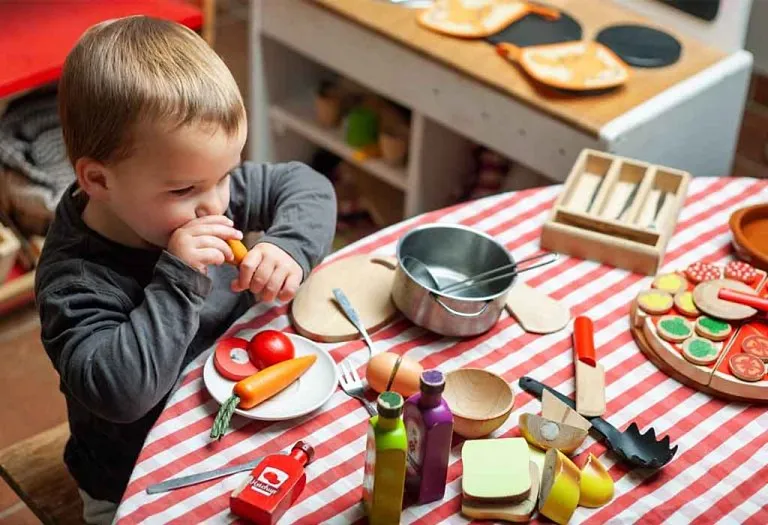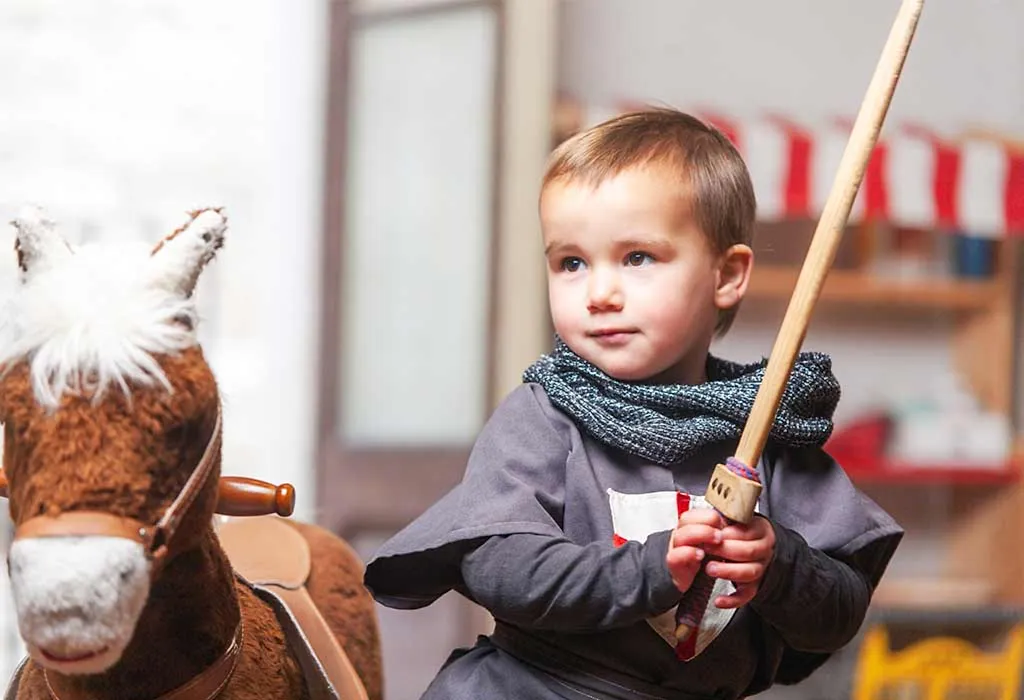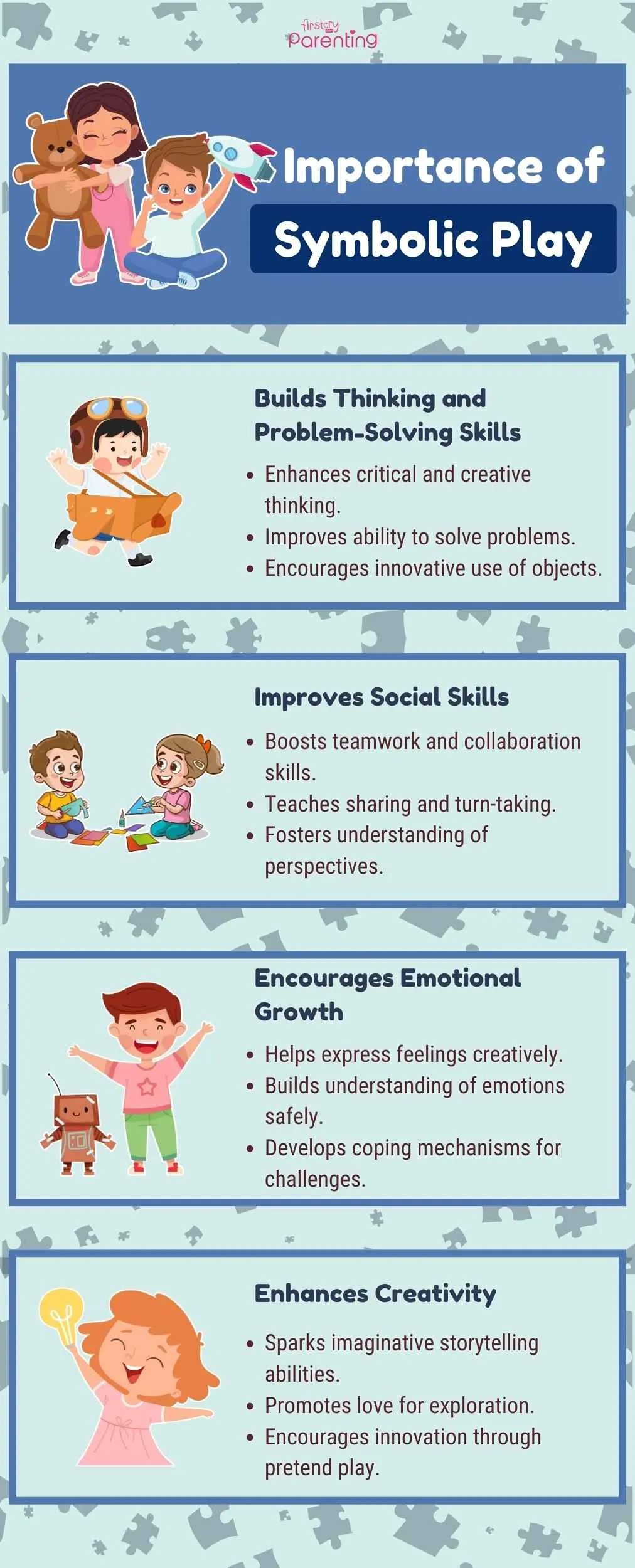Symbolic Play – Importance and Tips To Encourage It
Children are naturally inquisitive and imaginative, and one of the best ways this creativity manifests is through symbolic play. Also called pretend play, this form of play involves children using objects, actions, or ideas to represent something else. For instance, a child might use a cardboard box as a spaceship or pretend a wooden block is a smartphone. Symbolic play begins in early childhood and becomes more sophisticated as children grow, forming a cornerstone of their cognitive and social development.
Why is symbolic play important? Besides all fun, this type of play enhances problem-solving skills, encourages emotional expression, and builds healthy communication. Parents and caregivers are influential in nurturing these abilities by creating supportive environments that inspire imaginative exploration. In this article, we’ll look into the significance of symbolic play and practical tips to encourage it effectively.
What Is Symbolic Play?
Symbolic play is when children use their imagination to transform objects, actions, or roles into something else. For example, they might pretend a chair is a car or act like a superhero saving the day. This form of play is a natural way for kids to explore the world around them and make sense of it.
A simple symbolic play definition is using creativity to represent one thing as another. It can involve toys, everyday objects, or even imaginary friends.
Stages of Symbolic Play
Symbolic play develops in stages as children grow and their imagination expands. Each stage reflects their increasing ability to think creatively and use objects or actions in more complex ways. Understanding these stages of symbolic play will help parents and caregivers support their child’s development.
1. Early Imitation (12–18 Months)
- Children start by imitating simple actions they see in daily life, like pretending to drink from an empty cup or talking on a toy phone.
- Play is often short and focuses on familiar routines.
2. Simple Pretend Play (18–24 Months)
- At this stage, kids begin assigning basic roles to objects, like using a block as a car.
- They start creating short pretend scenarios, often involving themselves or a caregiver.
3. Role-Based Play (2–3 Years)
- Children take on roles like a teacher, doctor, or parent during play.
- Their scenarios become more detailed, often involving a sequence of actions.
4. Interactive Play (3–5 Years)
- Group play becomes common as kids work with peers to create shared storylines.
- They develop characters, solve problems in their stories, and use dialogue to communicate ideas.
5. Advanced Symbolic Play (5+ Years)
- Play becomes elaborate with complex plots, combining real and imaginary elements.
- Children use their creativity to explore abstract ideas or mimic adult-like roles in detail.
Importance of Symbolic Play
Symbolic play is a key part of a child’s development, helping them grow in many ways. It goes beyond fun and encourages learning through imagination and creativity. Here are some important reasons why symbolic play matters.
1. Builds Thinking and Problem-Solving Skills
- When children pretend, they learn to think critically and solve problems.
- Figuring out how to act out a story or use an object creatively boosts their ability to think in new ways.
2. Improves Social Skills
- Playing with others helps kids learn cooperation and teamwork.
- They practice sharing, taking turns, and understanding different perspectives.
3. Encourages Emotional Growth
- Symbolic play gives children a way to express their feelings safely.
- Acting out scenarios helps them understand emotions like joy, fear, or frustration.
4. Enhances Creativity
- Pretend play sparks imagination by encouraging children to create their own stories.
- It fosters a love of exploration and innovation from an early age.
When Do Children Develop Skills Necessary for Symbolic Play?
Children begin to develop the skills needed for symbolic play as they grow and explore their surroundings. These skills emerge gradually, influenced by their age, experiences, and interactions. Below are the key stages when symbolic play skills typically develop.
1. Sensory Exploration (0–12 Months)
- Babies start by exploring objects through touch, sight, and sound.
- This exploration builds the foundation for understanding how objects can represent other things later.
2. Imitation of Actions (12–18 Months)
- Around this age, children begin imitating simple actions like pretending to eat or talking on a phone.
- This marks the start of connecting real-world experiences to play.
3. Early Pretend Play (18–24 Months)
- Toddlers start using objects symbolically, such as pretending a block is a car.
- They also begin acting out short, imaginative scenarios with toys or household items.
4. Role-Playing and Storytelling (2–4 Years)
- By this stage, children take on roles like a parent or doctor and engage in more detailed pretend play.
- They use creativity to build stories, enhancing their symbolic play skills further.
Examples of Symbolic Play
Symbolic play can take many forms, which allows children to express their imagination and creativity. It often involves everyday objects, toys, or even purely imaginary elements. Below are a few common examples of symbolic play that highlight its versatility.
1. Pretending with Objects
- Using a cardboard box as a car, house, or spaceship.
- Turning a spoon into a magic wand or sword.
2. Role-Playing
- Acting as a teacher, doctor, or shopkeeper.
- Pretending to be a parent feeding or caring for a doll.
3. Imaginary Friends or Scenarios
- Inventing a superhero identity and saving the day.
- Creating adventures with imaginary friends or animals.
How to Encourage Symbolic Play?
Encouraging symbolic play helps children grow their imagination and creativity while also building important skills. Parents and caregivers can create the right environment and offer gentle guidance to support this type of play. Here are some practical ways to promote symbolic play effectively.
1. Offer Simple and Flexible Toys
Open-ended toys are perfect for fostering symbolic play because they can be used in many ways. Blocks, dolls, and stuffed animals can spark creativity as children decide their purpose during play. For example, blocks can become a castle, a car, or even food in a pretend picnic. Avoid toys with only one specific function, as they limit imaginative possibilities. You don’t need expensive items—household objects like spoons or cardboard boxes work just as well. Providing a mix of materials encourages children to think inventively and adapt their play ideas.
2. Create a Space for Pretend Play
Have a dedicated area for symbolic play, so children are inspired to explore their imagination. This space doesn’t have to be large; it could be a corner of a room filled with costumes, props, and simple toys. Items like hats, scarves, or empty containers can become treasures in a child’s pretend world. You might also rotate items occasionally to keep their interest alive. For example, today, the space might be a bakery, and next week it could transform into a hospital. Giving them ownership to transform an object into multiple imaginative characters or entities encourages independent play and helps them immerse themselves in creative scenarios.
3. Participate in Their Play
Join your child’s pretend play to help boost their creativity. You can let them lead the way and follow their instructions, becoming part of their imaginative world. For instance, if they pretend to be a chef, you could play the role of a customer or a kitchen helper. Your participation can inspire them to add more layers to their stories while also giving you a chance to bond. However, they should be given the freedom to guide the play so that they remain in control of their creative process.
4. Encourage Creativity Through Storytelling
Storytelling is a wonderful way to enhance symbolic play. Encourage your child to make up stories and guide their play using narratives. For example, in between the play while they are narrating it, you may ask, “What will the princess do next?” or “How did the superhero save the day?” Open-ended questions spark ideas and help children develop plots during play. You can also read stories together and encourage them to recreate or extend those tales during pretend play. This not only enriches their imagination but also builds communication and problem-solving skills.
Symbolic Play Activities for Children
Symbolic play activities allow children to use their imagination while learning new skills. These activities can be adapted for all children and are especially helpful for those who may need extra support, such as exploring connections between autism and symbolic play. Below are some simple and enjoyable activities to try.
1. Host a Pretend Tea Party
Set up a pretend tea party with toy cups, plates, and a small table. Invite dolls, stuffed animals, or friends to join as guests. Encourage your child to serve pretend tea and snacks, adding conversations and actions to the scenario. This activity helps children practice social skills, turn-taking, and storytelling. For children with unique needs, such as those on the autism spectrum, it can be a gentle way to explore communication and role-playing in a safe and familiar setting.
2. Build a Cardboard Box Creation
Provide large cardboard boxes and let your child transform them into something imaginative. A box can become a car, a spaceship, or even a house. Encourage them to decorate the box using crayons, markers, or stickers. This activity promotes problem-solving and creative thinking. Children on the autism spectrum may enjoy structured tasks like designing and decorating, which help bridge the gap between autism and symbolic play, encouraging both focus and imagination.
3. Create a Dress-Up Corner
Fill a box with costumes, hats, scarves, and accessories for your child to explore. They can become doctors, chefs, or superheroes, acting out different scenarios. Encourage them to make up their own stories and roles. Dressing up supports symbolic play by helping children practice empathy and explore different perspectives. For children with autism, this can be a fun way to learn about social roles and develop communication skills through pretend scenarios.
4. Run a Puppet Show
Use hand puppets or create simple ones from socks and paper bags. Let your child create a story and act it out with the puppets. This activity develops storytelling, language skills, and creativity. It’s especially helpful for children who may find direct interactions challenging, as puppets can serve as a bridge to connect verbal and non-verbal communication. For children with autism, puppet play can encourage symbolic representation while reducing social pressure.
5. Toy Kitchen or Pretend Cooking
Set up a toy kitchen with utensils, pans, and pretend food, or use real kitchen tools like plastic bowls and spoons. Encourage your child to cook meals, host a pretend restaurant, or serve a pretend meal to family members. This activity enhances creativity, planning, and organizational skills. For children with autism, structured pretend cooking can combine familiar routines with imaginative elements, supporting both play and daily life skills.
6. Adventure with a Fort
Use pillows, blankets, and chairs to build a fort. Let your child decide if it’s a castle, a cave, or a spaceship. They can invite friends, siblings, or toys to join their adventure. Decorating or adding stories to the play strengthens creativity and teamwork. For children on the autism spectrum, the physical act of building and the imaginative storytelling inside the fort can help connect sensory experiences with symbolic play in a comforting environment.
Symbolic Play and Activities for a Child with Autism
Symbolic play is important for children with autism as it helps them develop creativity, communication, and social skills in a safe environment. Activities tailored to their needs can make this play more engaging and beneficial. Below are a few simple yet effective symbolic play activities for children with autism.
1. Pretend Play with Favorite Toys
Use familiar toys or objects your child enjoys, like cars or animals. Encourage them to create simple scenarios, such as a car race or animals going to sleep. Familiar items make it easier for children to engage while gradually introducing them to symbolic representation.
2. Puppet Role-Playing
Use puppets or stuffed animals to act out simple stories. For example, a puppet could pretend to eat or go to the park. This activity promotes communication and allows children to explore emotions through the puppets, which can feel less overwhelming than direct interactions.
3. Sensory-Based Pretend Cooking
Set up a pretend kitchen using real ingredients like dry rice or pasta and toy utensils. Encourage the child to mix and “cook” meals. This combines sensory play with imagination, helping them explore symbolic play while enjoying tactile stimulation in a controlled setting.
4. Dress-Up with Simple Costumes
Provide simple costumes, like hats or capes, and let the child explore different roles. They can act as a superhero, chef, or animal. This fosters creativity while supporting role-playing in a low-pressure and enjoyable way.
What If a Child Doesn’t Participate in Symbolic Play?
Some children may not naturally engage in symbolic play, and that’s okay. Every child develops at their own pace, and some might prefer other types of play, like physical or sensory activities. If a child shows little interest in symbolic play, gentle encouragement and the right support can help.
Infographic
FAQs
1. What is pre-symbolic play?
Pre-symbolic play refers to the early stage of play where children explore objects without assigning symbolic meaning. For example, a child might shake a rattle to hear the sound or stack blocks without pretending they are something else. It lays the foundation for symbolic play by helping children understand how objects work.
2. At what age does symbolic play begin?
Symbolic play typically begins around 12 to 18 months when children start using objects to represent something else. For example, they might pretend a block is a car. This stage follows pre-symbolic play, where children primarily explore objects through sensory activities.
3. Why is symbolic play important for language development?
Symbolic play encourages children to use words and actions together in pretend scenarios, helping them practice new vocabulary. For example, when acting out a tea party, they might use words like “cup,” “tea,” or “pour.” This supports both language and cognitive development.
4. How can I encourage symbolic play in a child with autism?
Children with autism might benefit from structured symbolic play activities using familiar objects. Start with simple tasks, like pretending to feed a toy animal, and gradually build more complex scenarios. Combining sensory elements with pre-symbolic play can also help engage their imagination.
5. Can symbolic play help with emotional expression?
Yes, symbolic play allows children to explore and express their new emotions in a safe and creative way. For instance, a child might act out a story about being scared or happy through pretend scenarios. This type of play helps them understand and process their feelings better.
Symbolic play is an important part of a child’s growth that helps them develop creativity, language, and problem-solving skills. It supports emotional expression and teaches social interaction in a fun and natural way. You can encourage this type of play by providing the children with simple tools and engaging with their child’s imagination. Activities like role-playing, pretend cooking, or building with blocks can make learning enjoyable. For children with unique needs, like autism, structured symbolic play is ideal as it supports children to grow at their own pace. Remember that every child develops differently, so patience and encouragement are key. By supporting symbolic play, you’re giving your children the tools to explore, learn, and connect with the world around them.
Also Read:
Significance of Play and Movement for Babies
Best Games to Play with Babies
Baby Activities – Fun Things To Do With Your Babies
Was This Article Helpful?
Parenting is a huge responsibility, for you as a caregiver, but also for us as a parenting content platform. We understand that and take our responsibility of creating credible content seriously. FirstCry Parenting articles are written and published only after extensive research using factually sound references to deliver quality content that is accurate, validated by experts, and completely reliable. To understand how we go about creating content that is credible, read our editorial policy here.



























